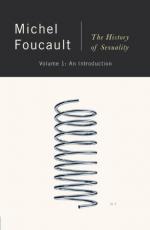
|
| Name: _________________________ | Period: ___________________ |
This test consists of 5 multiple choice questions, 5 short answer questions, and 10 short essay questions.
Multiple Choice Questions
1. Attempt at regulation, or the deployment of alliance, of sexuality had what important effect?
(a) Generated perversions.
(b) Regulation helped spread the sexual discourse and hence sexuality.
(c) Constrained sexuality to marital relations.
(d) Gave power to institutionalized strategies.
2. Which of the following does Foucault NOT say about the mechanics of power over sexuality?
(a) It only has the power to say no and to produce limits.
(b) It is poor in resources, sparing in it's methods, and monotonous in tactics.
(c) It is dependent on the biological consequences of disobedience.
(d) It is juridical in nature, centered on nothing more than the statement of law.
3. What does Foucault say about resistance?
(a) All of the above.
(b) There are points of it present everywhere in the power network.
(c) There is a single source of all resistence.
(d) It derives from a few heterogeneous principles.
4. Which of the following is a statement made by Foucault?
(a) Scientia sexualis is a more valid and evolved pursuit of truth than ars erotica.
(b) Western societies did not manifest the movement of a power that was essentially repressive.
(c) The format of the confessional is our best remedy to repression.
(d) Sexuality has been repressed by the general consent of the populace.
5. The hysterical woman and the onanistic child were likely to have stemmed from what aspect of their existence in their specific social class?
(a) Knowledge without resource.
(b) Idleness and obligation to preserve a healthy line of descent.
(c) Inbreeding and lower moral fiber.
(d) Financial difficulty and lack of education.
Short Answer Questions
1. If one tries to define the history of sexuality by mechanisms of repression, there are two "ruptures" that Foucault identifies and says warrants further investigation. Which of the following is NOT either a description of one of the ruptures or the time period it took place?
2. What does the rule of double conditioning state?
3. Which of the following best characterizes the techniques of sexuality from the sixteenth century onward?
4. What relationship does Foucault give to governmental powers and law?
5. What does the rule of immanence state?
Short Essay Questions
1. What is the pedagogization of children's sex?
2. How did sexuality spread to the general population?
3. In what form did sexuality first arise, and what was its intended purpose?
4. Per Foucault, what are the principle traits of juridico-discursive power structures?
5. How does sexuality vary between classes?
6. What is the hysterization of women's bodies?
7. Explain the concept of juridico-discursive power. Where does Foucault say we perceive it to act?
8. What is the socialization of procreative behavior?
9. Explain the principles of negative relation and the cycle of prohibition in the juridico-discursive power structure.
10. Relationships between power and knowledge are transformational matrices and highly subject to change. Give an example of a power-knowledge relationship that has changed dramatically.
|
This section contains 1,123 words (approx. 4 pages at 300 words per page) |

|




